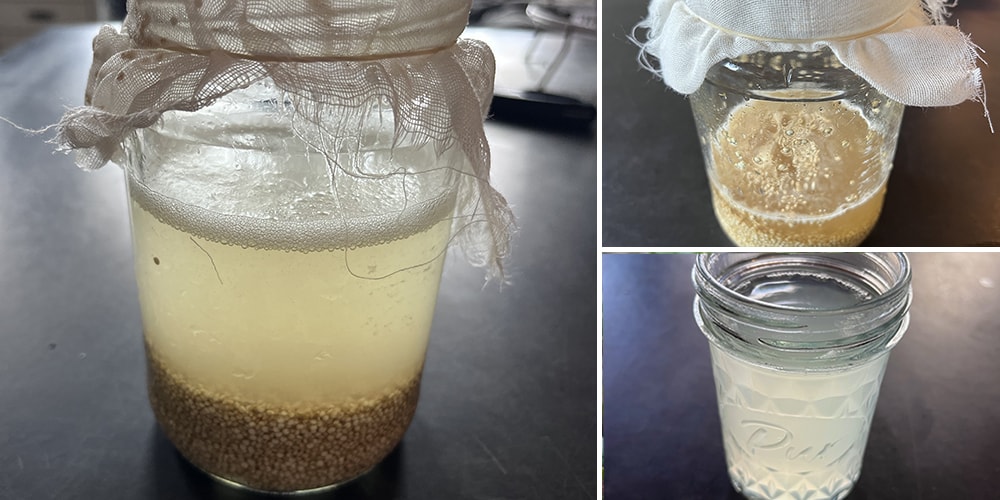
How to Make Rejuvelac for Leaky Gut
Are you suffering from a leaky gut and looking for a natural solution to promote gut health? Rejuvelac, a fermented beverage made from grains, might just be the answer you’re seeking.
Although it has a strange-sounding name, Rejuvelac is an old recipe that has been used for centuries in Europe. It’s easy to make at home and has multiple health benefits. It also has a refreshing bright flavor (although, some might say it’s an acquired taste), making it a great addition to your daily routine. So, let’s dive in and learn how to make this rejuvenating elixir!
Leaky Gut Symptoms
Leaky Gut is a term that is used to describe a condition where the intestinal lining becomes more permeable, allowing toxins, bacteria, and undigested food particles to pass into the bloodstream. This may trigger inflammation and immune reactions that can cause various symptoms, such as: bloating, gas, cramps, food sensitivities, aches and pains, fatigue, headaches, joint pain, skin problems, or mood swings.
However, other gastrointestinal diseases are also known to be associated with increased intestinal permeability, such inflammatory bowel disease (IBD) and celiac disease. You should discuss with your healthcare provider for a proper diagnosis.
What is Rejuvelac?
Rejuvelac is a fermented beverage made from sprouted grains. It originated in the Black Sea region and has been used as a health tonic for centuries. The fermentation process breaks down complex carbohydrates and proteins into simpler components, making it easier for your body to absorb the nutrients.
Thanks to the fermentation process, Rejuvelac is rich in beneficial enzymes, probiotics, vitamins, and minerals, which can help improve digestion and support a healthy gut.
Benefits of Rejuvelac
Rejuvelac offers a range of health benefits, particularly for those with gut concerns. Some of the advantages of Rejuvelac include:
Improved digestion: The enzymes in Rejuvelac help break down food more efficiently, allowing your body to absorb nutrients more effectively.
Boosted immune system: The probiotics in Rejuvelac support the growth of beneficial gut bacteria, which can enhance your immune system.
Reduced inflammation: Rejuvelac can help reduce inflammation in the gut, which is often associated with leaky gut syndrome.
Detoxification: Rejuvelac helps to cleanse the digestive system, promoting the elimination of toxins.
Increased energy levels: Rejuvelac provides a natural energy boost, making it an excellent alternative to caffeine-laden beverages.
Types of Grains You Can Use to Make Rejuvelac
Rejuvelac can be made with a variety of grains, as long as they are sprouted first. Sprouting grains “awakens” them, and breaks down the outer protective barrier, making it easier for your body to access and absorb the nutrients inside.
The sprouting process also increases the protein content of grains by breaking down complex proteins into simpler amino acids, which are more easily absorbed by the body. This is especially helpful for those suffering from a leaky gut, as it can help repair your gut lining.
Additionally, the sprouting process increases the antioxidant content and reduces the gluten content in the grains. Long story short: you’ll want to sprout your grains before using them to make Rejuvelac. It’s a simple process, and we’ll show you how in a moment.
While Rejuvelac can be made from a variety of grains, some popular options include:
Wheat: One of the most common grains used for Rejuvelac, wheat provides a mild, slightly sweet flavor.
Rye: Rye is another popular choice, offering a slightly more robust taste than wheat.
Barley: Barley lends a nutty, rich flavor to Rejuvelac.
Millet: This gluten-free grain gives Rejuvelac a slightly bitter taste.
Quinoa: A highly nutritious and gluten-free option, quinoa provides a unique, slightly tangy flavor.
For this recipe, I chose to use quinoa (Chenopodium quinoa).
Additionally, this Balanced/Leaky Gut Tincture contains six anti-inflammatory and soothing herbs that help repair the intestinal tract and restore healthy gut function.
Benefits of Quinoa
Quinoa (Chenopodium quinoa), a pseudo-grain native to South America, is highly valued for its nutritional content.
Quinoa is rich in protein and contains all nine essential amino acids that your body needs. It’s also high in fiber, naturally gluten-free, and packed with minerals and anti-inflammatory nutrients.
In my experience, it’s also very easy to sprout and ferment, and you can make a Rejuvelac drink from start to finish in 3-4 days.
How to Make Rejuvelac Out of Quinoa
Making Rejuvelac from quinoa is a simple process that requires just a few steps and simple ingredients. Here’s everything you’ll need:
Ingredients:
- 1/2 cup of organic quinoa
- 2 cups of filtered water
- A large glass jar (at least 1-quart capacity)
- A cheesecloth or mesh sprouting lid
- A rubber band (if using cheesecloth)
Instructions:
Step 1: Rinse and Soak the Quinoa
Thoroughly rinse the quinoa under cold water using a fine-mesh strainer to remove any dust or debris. Place the rinsed quinoa in the glass jar and add enough filtered water to cover it. Let it soak for 6-8 hours or overnight.
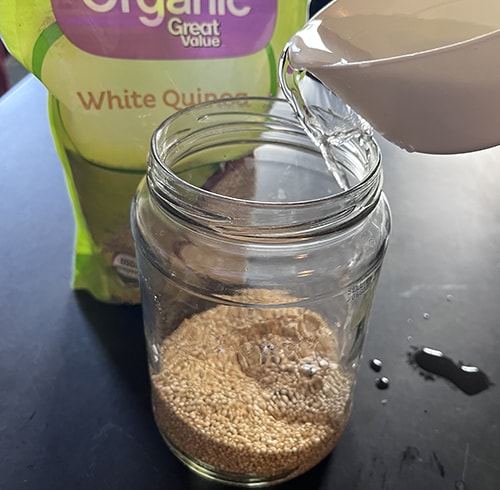
Step 2: Drain and Rinse
After the soaking period, drain the water from the jar through the cheesecloth or mesh sprouting lid. Rinse the quinoa under cold water, then drain again. If using a cheesecloth, secure it with a rubber band.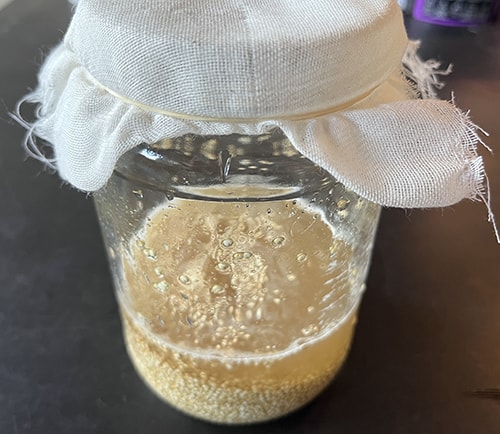
Step 3: Sprout the Quinoa
Place the jar at an angle, allowing any excess water to drain while providing airflow. Leave the jar in a dark place at room temperature for 24-48 hours, rinsing and draining the quinoa every 8-12 hours. You should see small sprouts emerging from the quinoa.
Note: if there is too much water, the quinoa may start to rot instead of sprouting. To avoid that, make sure to drain all the water out. The goal is to leave the grain moist, not drowning in water. If your sprouts start to smell funky or develop mold, it’s best to throw them away and start a new batch.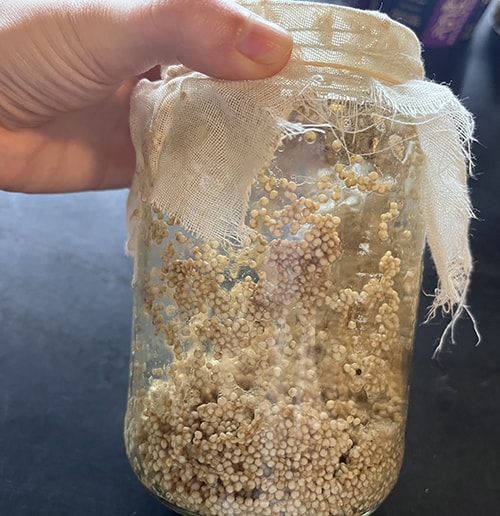
Step 4: Ferment
Once the quinoa has sprouted, add 2 cups of filtered water to the jar, covering the sprouted quinoa. Cover the jar with the cheesecloth or mesh sprouting lid, and let it sit at room temperature for 24-72 hours. Taste the Rejuvelac daily – it should have a tangy, lemony flavor when it’s ready. It will also take on a light yellow, slightly opaque appearance and some bubbles indicating that the fermentation process is well underway.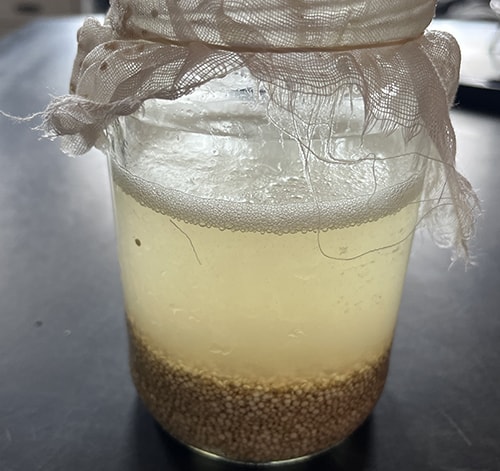
Step 5: Strain and Store
Once the Rejuvelac has reached the desired taste, strain the liquid through a fine-mesh strainer or cheesecloth into a clean jar or bottle, discarding the spent quinoa. Your Rejuvelac is now ready to enjoy!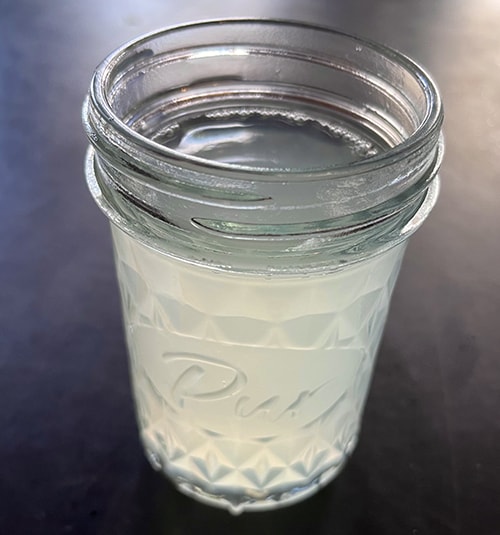
How to Use Rejuvelac
Rejuvelac can be consumed on its own or incorporated into various recipes for added health benefits.
The most popular way to consume it is to just drink it straight. You can have ½ – 1 cup of straight Rejuvelac daily to support your gut health. You can keep it at room temperature or chill it, depending on your preference.
If you’re not enjoying the natural tangy flavor (you’re not alone!), you can add some honey, or even kombucha to it to make it taste better.
Another great way to get your daily Rejuvelac is to use it as a base for smoothies. Instead of water or milk, add some Rejuvelac to your fruits and veggies, before blending it all up. This tends to mask the flavor completely, and seriously boosts the nutritional value of your smoothies!
Other ways to get creative with Rejuvelac is to use it in your homemade salad dressings. Replace vinegar or lemon juice. Rejuvelac is also used as a base to create vegan cheese, because it adds that cheesy fermented flavor that we love so much.
How to store: Once it has been strained, Rejuvelac should be stored in an airtight container in the refrigerator to maintain freshness and prevent spoilage. Properly stored Rejuvelac can last for up to two weeks in the fridge. If you notice an off smell, mold, or any signs of spoilage, discard the Rejuvelac and make a fresh batch.
Final Thoughts
Rejuvelac, made from nutrient-rich quinoa, is a natural and effective solution for promoting gut health and alleviating symptoms of a leaky gut. By incorporating this fermented beverage into your daily routine, you can enjoy a range of health benefits, from improved digestion to boosted energy levels. So go ahead and give this rejuvenating elixir a try – your gut will thank you for it!

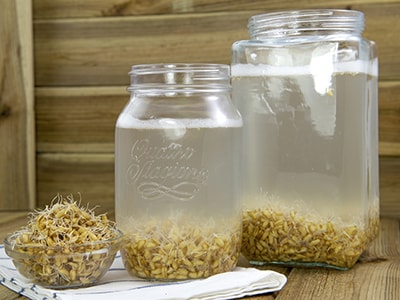
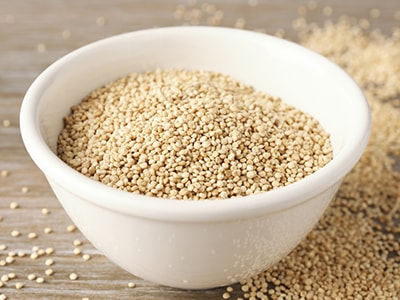

*IBS is generally associated with Irritable Bowel Syndrome. IBD is for Inflammatory bowel disease
Hi Emmi,
Thank you for pointing this typo out!
Many blessings and good health!
How long would someone have to take this? Does it help repair the gut lining or only mask the symptons? Thanks. Pat N.
Hi Patricia,
Rejuvelac can help reduce inflammation in the gut, which is often associated with leaky gut syndrome. It also helps to cleanse the digestive system, promoting the elimination of toxins. The active or “live” cultures of probiotics in this healthy drink are lactobacilli and bifidobacteria. These bacteria help to restore balance to the gut flora, which is essential for good health.
There is no specific duration for taking rejuvelac. It can be consumed as a regular part of your diet. You will have to try it yourself for at least a couple of weeks to see if you notice any improvement.
Many blessings and good health!
Thought… after the 24-72 hours second soak, instead of throwing out the grain, could it not be drained – saving the drink of course – and the grains sprouted for consupmption.
Hi Paul,
Thank you for your comment! Yes, this is a good idea!
Many blessings and good health!
It probably just replaces the gluten that you would have eaten had you not used the sprouts.
I have seen colonoscopy photos of myself when I was eating gluten and 5 years later when I had gone without. When I was first eating gluten my intestinal photos were “squeaky clean” and looked like plastic. Squeaky clean is not good. After I had rebuilt my intestinal wall, 5 years later, the intestinal wall was not clean looking and the surface was slightly coarse, the way it should be.
Hi Tom,
Thank you so much for taking the time to share your experience with all of us! We really appreciate it. We’re happy to hear you’re better now.
When making your rejuvelac, you must use gluten-free grains like quinoa seeds, rye berries or teff.
Many blessings and good health!
Grains help literally cause leaky gut…why would you give someone more of it
Agreed. For anyone who is gluten or wheat sensitive, rejuvelac might not be a good idea (unless you make it from gluten free grains only). Gotta be careful! Hard to get the desired enzymes without ingesting the gluten proteins too.
Hi Shawna,
When making your rejuvelac, it’s best to use gluten-free grains like quinoa seeds, rye berries or teff.
Many blessings and good health!